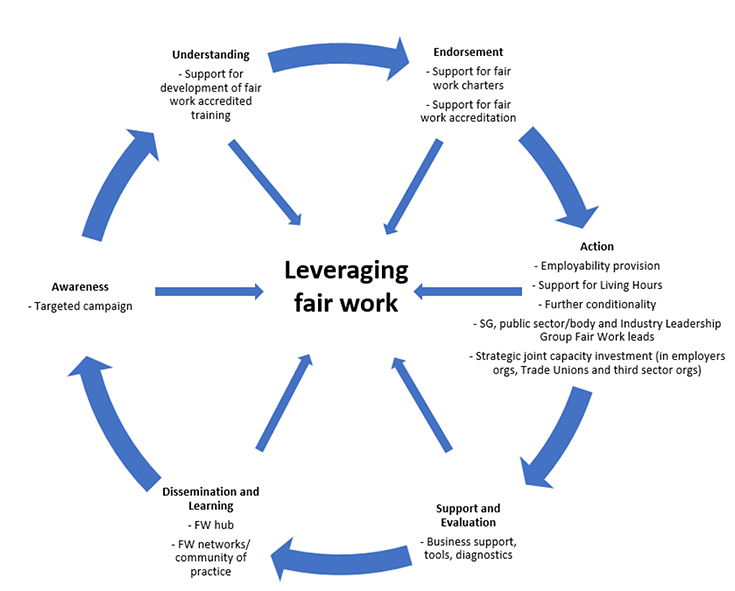Framing potential levers
The starting point for framing and identifying feasible levers to further drive fair work in Scotland is what government/policymakers can do in relation to fair work in general, its five core dimensions and the many practices that underpin these dimensions. Other workplace actors have different capabilities, reach and options that are not available to policymakers: for example, employers could choose to implement a wider range of fair work supporting practices without influence from government/policymakers. The NATO framework helps outline government’s direct and indirect forms of influence.
A second element in thinking about potential levers is to consider which actors might most usefully be influenced. The initial focus of potential policy levers is often on collective actors (like employers’ organisations or trade unions), but only as channels to inform and influence the practice of individual workplace stakeholders. The workplace is the space where fair work is experienced and implemented, and so engagement with higher level actors is only of value where it has the potential to influence workplace practice.
We deployed a bespoke framework of change towards fair work informed by and developed from the broad body of research on individual and organisational learning. We pose that fair work is supported through a range of both separate and connected as well as self-reinforcing mechanisms, beginning with increasing awareness of fair work; improving understanding of what fair work means; embedding endorsement of fair work; taking action to deliver fair work; supporting fair work actions and their evaluation; and disseminating lessons learned on fair work, that feedback into improved awareness of fair work in practice and in context.
Using this approach, the research first identified a set of policy levers to consider as having any potential to enhance the adoption of fair work in Scotland. The diagram below captures both the framing approach and the practices identified.
These practices meet the tight constraints previously outlined in the methods section above. The circle represents the framework of change in fair work and the different stages of the mechanisms that can support fair work. Twelve possible levers are identified and discussed. The internal arrows make clear that each lever can impact fair work on their own, while the external arrows indicate how levers might reinforce each other. The diagram outlines, but does not endorse, possible levers, with each lever reviewed for potential effectiveness and feasibility in the following sections of this Report.

We now turn to a detailed discussion of specific levers (identified above) that the Scottish Government and its partners might consider in promoting fair work, organised in relation to the NATO framework described earlier, and summarised in the Table below.
| Authority | Treasure | Nodality | Organisation |
|---|---|---|---|
| Targeted awareness campaign | Further conditionality | Development of accredited fair work training | Business support, tools and diagnostics |
| Embedding fair work in employability provision | Strategic joint capacity investments | Support for fair work charters | Support for a fair work hub |
| Support for Real Living Hours | Support for formal fair work accreditation | ||
| SG, public sector/body and ILG fair work champions | Support for fair work communities of practice |
The NATO framework allows us to consider how government can influence in different ways and at different stages. For example, there may be times and priorities where the role of government focuses on ‘nodality’, providing the foundation and networking capabilities for information exchange. At other times, the policy focus may be on ‘authority’, for example, requiring certain actions of those government contract with). The discussion begins with ‘Authority’ - those levers wholly within the power of the Scottish Government or local government in Scotland.